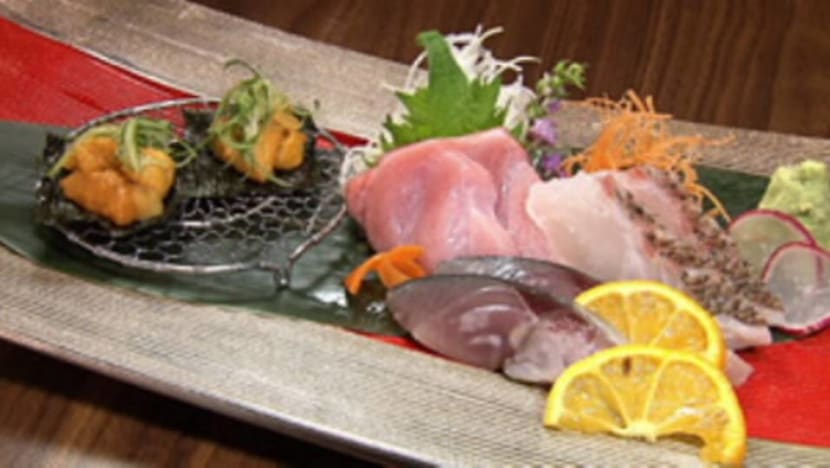Japanese Tech and Fresh Seafood
Japanese cuisine is gaining popularity around the world and sushi and sashimi are among the more well-known items. For example, in Singapore, the number of Japanese restaurants has been increasing over the years. But some say that when one eats Japanese food abroad, it does not taste as good as in Japan.

Japanese Tech and Fresh Seafood
Japanese cuisine is gaining popularity around the world and sushi and sashimi are among the more well-known items. For example, in Singapore, the number of Japanese restaurants has been increasing over the years. But some say that when one eats Japanese food abroad, it does not taste as good as in Japan.
For instance, salmon is a popular choice when eating sushi and sashimi. Salmon is served with avocado and ikura, it is used instead of seaweed to wrap gunkan maki or there is even seared salmon with mentaiko. However, 63 per cent of all the salmon consumed in the world comes from either Norway or Chile.
Nonetheless, the consumption of fish in foreign countries is increasing. People in advanced nations are believed to care more about their health and prefer fish with less fat, while people in developing countries are said to eat fish as a source of protein because it's cheaper than meat. So JF Zengyoren, a national organisation of Japanese fishermen’s unions, seeks to promote Japanese seafood to overseas markets to boost the domestic fish industry. Examples are sea bream and amberjack from Ehime, shrimp from Fukui, and sea urchin and scallops from Hokkaido.
There are also companies which are now delivering Japanese fish to other countries. An essential component of this process is to keep the fish fresh and some Japanese firms have come up with different technologies to maintain the freshness of the fish they export. One of the popular destinations for exporting Japanese fish is the gourmet city of Hong Kong. At certain stores here, one can find Japanese seafood such as squid from Hokkaido, horse mackerel from Shimoda and tuna from Kyushu, among other Japanese food items.
At one sushi restaurant in the centre of Hong Kong, for example, fresh flounder from Japan is shipped in from Aomori - one of the biggest producers of flounder - in boxes. The flounder is packed in a bag with sea water and oxygen. Fresh octopus and scallops are also delivered this way. The seafood is brought in by a shipping service of the Yamato Transport Co. A refrigerated truck of the courier service first leaves the fish market in Aomori the previous day at 8.30am and arrives at Sendai Airport at 3pm. The seafood is then transferred to a refrigerated container, which is then loaded onto a regular passenger plane which departs from Sendai at 5.30pm. The extra space in passenger planes is used to reduce costs as shipping Japanese fish overseas can be quite expensive. The flounder is shipped from Aomori to Hong Kong via Osaka, so the plane goes to Itami Osaka Airport.
Later, the box is transported to Naha Airport in Okinawa on an ANA cargo plane. The airport, which operates all day, was designated a special site of international logistics in 2002. ANA Yamato Transport Co and Okinawa worked together to set up a logistics system here. The container with the flounder is unloaded again and moved to the Okinawa Cargo Hub at the north of Naha Airport.
International packages are sorted at the cargo hub. The containers with seafood are opened in a cold room for temperature management. In fact, there is a system to maintain the temperature from shipping to delivery. The packages need to clear customs for international shipping after which the cargo plane departs. It takes about 1.5 hours to fly to Hong Kong, and less than four hours to reach other major cities in Southeast Asia. The cargo plane touches down at Hong Kong Airport at 7.45am (Japan Standard Time) and the boxes are then transported to the restaurant and reach there just after noon, about 30 hours since they left Aomori.
There are many techniques in Japan to keep seafood fresh while it is being transported to foreign countries. For instance, a company called Maruhuku Suisan in the fish market in Kokura, Fukuoka has developed a method to keep seafood fresh. Fish such as red sea bream and amberjack are shipped to Canada. The company uses a technique, Nano Water, to keep the fish alive. The wholesalers put the fish in ice and water. A machine, Nano Fresher, is used to create many nitrogen bubbles called nano bubbles. Nitrogen delays oxidization and keeps the fish fresh. The seafood is delivered to Japanese restaurants in Canada via an intermediate wholesaler in Canada.
Another device to maintain the freshness of seafood can be found in Gifu. It was invented by Makoto Nagai. Live fish such as greenling, an expensive shorefish, is placed in the device. Oxygen, nitrogen and carbon dioxide are put in and pressure is added for nearly an hour. By now, the fish is “asleep”; it is then put in water and ice and placed in a refrigerator. Two hours later, the fish is taken out of the refrigerator and put into the device again. Pressure is added for 50 minutes and amazingly, the fish starts swimming.
Meanwhile, there is a company in Chiba which keeps seafood fresh in a huge CAS freezer. An oyster, for instance, can remain fresh in it for a year. The freezer uses things such as magnetic force and sound to freeze seafood and retain its freshness without changing the quality. For instance, an octopus which was frozen four years ago using the technology can be “revived”. The company believes this technology can be applied to ingredients other than seafood. An example is frozen cooked food which can be preserved in the same way.
Such technology will also help boost Japan’s export-oriented industries. The country plans to expand the export of agricultural, forest and fishery products to 1 trillion yen by 2020, compared to 611.7 billion yen in 2010. The export of fishery products was worth 233.7 billion yen and the authorities plan to increase this to 350 billion yen by 2020.
Tips:
1) Visit fairs or events held by overseas food associations to find out more about the country’s cuisine
2) Some restaurants get fresh seafood flown in from Japan to offer customers authentic Japanese dishes












